| FieldGuidetoQuilts.com | |
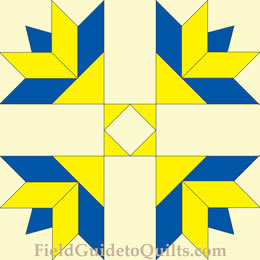
|
* Fanny's Fan & more |
Most of these stars' points are made of pairs of elongated diamonds that create chevron shapes.
We've included other blocks so similar that we wanted to cover them together.
 Four Queens Four Queens
|
Four Queens                Four Queens Four Queens Four Queens Four QueensCabot, 1936 Cabot wrote that the small triangles, to the whist player, resembled the crowns of four queens on a purple and yellow throne. Whist is a card game that was popular in the United States up into the 20th century. Then bridge ran it over and left tire tracks on its back. Bridge was an offshoot of whist that hailed from Greece via Russia, picking up the name biritch along the way. This is according to the Encyclopedia Brittannica, which is so august that it spells "-pedia" with the ae stuck together. If nothing else, the Æ tells you that they're much better than Wikipedia. Check out the article here. |
||||||
V. Block                         V. Block 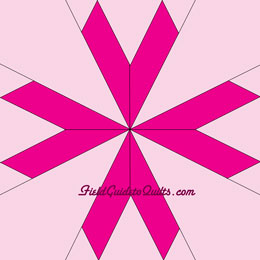 V. Block V. BlockLadies Art Company #483, 1922 Here's a factoid: The "war to end all wars" formally ended when Germany made the last of its reparation payments for the cost of the war — in 2010! | ||||||
V Block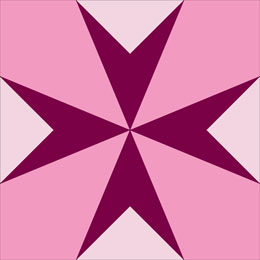                         V. Block V. Block V Block V BlockBeyer, 2009 The pieces in dark red make up a classic symbol called the Cross of Malta. |
||||||
Swing in the Center
Mrs. Roosevelt's Favorite/Swinging in the Center/Roman Pavement As was so often the case, Swing in the Center was first published in the Ladies Art Company catalog in 1897. Mrs. Roosevelt's Favorite was Clara Stone's name for it in her 1906 Practical Needlework; the other two names were from Nancy Cabot's column in the Chicago Tribune in 1934 and 1938 respectively. Finley Eight Hands Around/Ladies' Wreath Ruth Finley's variation of Swing in the Center differed from the LAC's in its construction: It has two-piece chevrons rather than three triangles, as in the LAC version. Her variation also used triangles for the corners instead of the LAC's spear points. In any case, the variation in Finley's 1929 book Old Patchwork Quilts: And the Women Who Made Them was picked up by Jane Alan (Illinois State Register, ca. 1932) and Nancy Page (Birmingham News, 1943). Laura Wheeler No copycat she, Laura Wheeler, the mysterious designer who drove the Old Chelsea Needlework Company's success, used rectangles instead of squares in her Swing in the Center variation to create a pronounced X shape from corner to corner. It makes a remarkable difference in the finished quilt. We're not sure how she arranged the colors. We built the color scheme around the light-colored chevrons to make the seams visible. |
||||||
Fannie's Fan
|
||||||
Fanny's Fan Fanny's Fan Fanny's FanLAC 1895                 Fanny's Fan (LAC) alternative layout                 Fanny's Fan (LAC)  The Ladies Art Company published Fanny's Fan in its 1895 catalog, according to records collected by Cuesta Benberry, who was possibly the 20th century's most revered quilt historian. The Ladies Art Company published Fanny's Fan in its 1895 catalog, according to records collected by Cuesta Benberry, who was possibly the 20th century's most revered quilt historian. The block at left is in the LAC's recommended colors—at least, as the LAC described them (the background was white). Its original diagram is green and orange on The Quilt Index web site, here: It's interesting to think that the 19th century might have used the same color names as we do for hues that weren't quite the same as ours. But the LAC's diagram may simply have faded in an odd way. The Quilt Index includes the original instructions and diagram. We found, however, that the diagram is not quite as precise as the ones that today's quilters use. Click on the "Make It!" icon for a slightly more consistent diagram drawn on a 40-square by 40-square grid. The other, similar blocks of this design are drawn on 10x10 grids. |
||||||
Fanny's Fan                Fanny's Fan (Hall)  Fanny's Fan Fanny's FanFinley, 1929                 Duck Paddle (Hall) The great benefit of a plus cross is that it creates a lattice pattern across the quilt top. This block, with its four-diamond corners, makes an exceptionally pretty one. Like most of the blocks on this page, it is laid out on a 10x10 grid. The block was first published in Finley's Old Patchwork Quilts (1929), but it popped up under Nancy Page's byline as Fanny's Fan in the Birmingham News in 1935. That was followed by Nancy Cabot's Point & Feathers in a 1936 Chicago Tribune. One more Fanny's Fan block was published in Carrie Hall's 1935 Romance of the Patchwork Quilt in America. Hall called the block Duck Paddle, with Fanny's Fan as an alternative name. It looks, to our eyes, identical to Finley's block, and thus based on a 10x10 grid. (Beyer's Quilter's Album uses a star grid.) 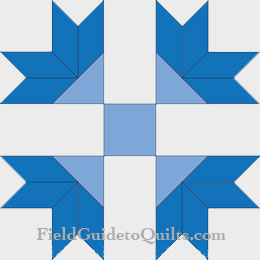 Duck Paddle Duck PaddleHall, 1935Perhaps it's not strictly necessary to include a graphic of Hall's block here, but with a name like Duck Paddle, how could we not? The photograph showed the block on point. Hall also included a Fanny's Fan in her quilt-block collection, now in the Spencer Museum of Art at Kansas University in Lawrenceville, Kansas. Hall's has a white background and a print for the lighter blue. You can see the block on the Spencer Museum web site. |
||||||
 |
||||||
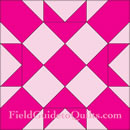



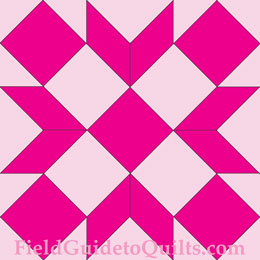 Swing in the Center
Swing in the Center Swing in the Center
Swing in the Center Fannie's Fan
Fannie's Fan